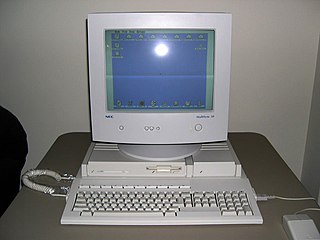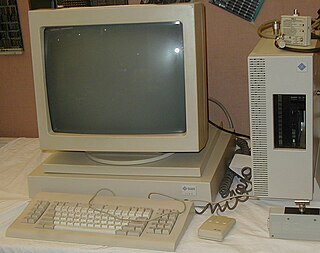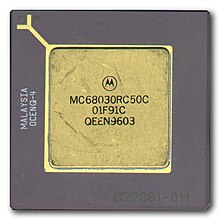
The Motorola 68020 is a 32-bit microprocessor from Motorola, released in 1984. A lower-cost version was also made available, known as the 68EC020. In keeping with naming practices common to Motorola designs, the 68020 is usually referred to as the "020", pronounced "oh-two-oh" or "oh-twenty".

The Motorola 68040 ("sixty-eight-oh-forty") is a 32-bit microprocessor in the Motorola 68000 series, released in 1990. It is the successor to the 68030 and is followed by the 68060, skipping the 68050. In keeping with general Motorola naming, the 68040 is often referred to as simply the '040.

The Motorola 68060 ("sixty-eight-oh-sixty") is a 32-bit microprocessor from Motorola released in April 1994. It is the successor to the Motorola 68040 and is the highest performing member of the 68000 series. Two derivatives were produced, the 68LC060 and the 68EC060.

The Motorola MC68010 and Motorola MC68012 are 16/32-bit microprocessors from Motorola, released in 1982 as successors to the Motorola 68000. The 68010 and 68012 added virtualization features, optimized loops and fixed several small flaws to the 68000. The MC68010 variants were pin compatible with its predecessor while the MC68012 is an 84-pin PGA version with its directly accessible memory space extended to 2 GiB.
The 88000 is a RISC instruction set architecture developed by Motorola during the 1980s. The MC88100 arrived on the market in 1988, some two years after the competing SPARC and MIPS. Due to the late start and extensive delays releasing the second-generation MC88110, the m88k achieved very limited success outside of the MVME platform and embedded controller environments. When Motorola joined the AIM alliance in 1991 to develop the PowerPC, further development of the 88000 ended.
The Motorola 68000 series is a family of 32-bit complex instruction set computer (CISC) microprocessors. During the 1980s and early 1990s, they were popular in personal computers and workstations and were the primary competitors of Intel's x86 microprocessors. They were best known as the processors used in the early Apple Macintosh, the Sharp X68000, the Commodore Amiga, the Sinclair QL, the Atari ST and Falcon, the Atari Jaguar, the Sega Genesis and Sega CD, the Philips CD-i, the Capcom System I (Arcade), the AT&T UNIX PC, the Tandy Model 16/16B/6000, the Sun Microsystems Sun-1, Sun-2 and Sun-3, the NeXT Computer, NeXTcube, NeXTstation, and NeXTcube Turbo, early Silicon Graphics IRIS workstations, the Aesthedes, computers from MASSCOMP, the Texas Instruments TI-89/TI-92 calculators, the Palm Pilot, the Control Data Corporation CDCNET Device Interface, the VTech Precomputer Unlimited and the Space Shuttle. Although no modern desktop computers are based on processors in the 680x0 series, derivative processors are still widely used in embedded systems.

The Amiga 2000 (A2000) is a personal computer released by Commodore in March 1987. It was introduced as a "big box" expandable variant of the Amiga 1000 but quickly redesigned to share most of its electronic components with the contemporary Amiga 500 for cost reduction. Expansion capabilities include two 3.5" drive bays and one 5.25" bay that could be used by a 5.25" floppy drive, a hard drive, or CD-ROM once they became available.

The Macintosh IIci is a personal computer designed, manufactured, and sold by Apple Computer, Inc. from September 1989 to February 1993. It is a more powerful version of the Macintosh IIcx, released earlier that year, and shares the same compact case design. With three NuBus expansion slots and a Processor Direct Slot, the IIci also improved upon the IIcx's 16 MHz Motorola 68030 CPU and 68882 FPU, replacing them with 25 MHz versions of these chips.

Amiga Unix is a discontinued full port of AT&T Unix System V Release 4 operating system developed by Commodore-Amiga, Inc. in 1990 for the Amiga computer family as an alternative to AmigaOS, which shipped by default.

The Macintosh II is a family of personal computers that was designed, manufactured and sold by Apple Computer, Inc. from 1987 to 1993. The Macintosh II was the initial model, representing the high-end of the Macintosh line for the time. Over the course of the next six years, seven more models were produced, culminating with the short-lived Macintosh IIvi and Macintosh IIvx models. Apple retired the Macintosh II name when it moved to Motorola 68040 processors; the Centris and Quadra names were used instead.
PowerPC G4 is a designation formerly used by Apple to describe a fourth generation of 32-bit PowerPC microprocessors. Apple has applied this name to various processor models from Freescale, a former part of Motorola. Motorola and Freescale's proper name of this family of processors is PowerPC 74xx.

The Atari Falcon030, released in 1992, is the final personal computer from Atari Corporation. A high-end model of the Atari ST line, the machine is based on a Motorola 68030 CPU and a Motorola 56001 digital signal processor, which distinguishes it from most other microcomputers of the era. It includes a new VIDEL programmable graphics system which greatly improves graphics capabilities.

A processor direct slot (PDS) is a slot incorporated into many older Macintosh models that allowed direct access to the signal pins of a CPU, similar to the functionality of a local bus in PCs. This would result in much higher speeds than having to go through a bus layer, such as NuBus, which typically ran at a slower 10 MHz speed.

The Atari TT030 is a member of the Atari ST family, released in 1990. It was originally intended to be a high-end Unix workstation, but Atari took two years to release a port of Unix SVR4 for the TT, which prevented the TT from ever being seriously considered in its intended market.

The Motorola 68881 and Motorola 68882 are floating-point units (FPUs) used in some computer systems in conjunction with Motorola's 32-bit 68020 or 68030 microprocessors. These coprocessors are external chips, designed before floating point math became standard on CPUs. The Motorola 68881 was introduced in 1984. The 68882 is a higher performance version produced later.

Sun-3 is a series of UNIX computer workstations and servers produced by Sun Microsystems, launched on September 9, 1985. The Sun-3 series are VMEbus-based systems similar to some of the earlier Sun-2 series, but using the Motorola 68020 microprocessor, in combination with the Motorola 68881 floating-point co-processor and a proprietary Sun MMU. Sun-3 systems were supported in SunOS versions 3.0 to 4.1.1_U1 and also have current support in NetBSD and Linux. It used to be supported by OpenBSD but the port was discontinued after the 2.9 release.

The Motorola 68851 is an external Memory Management Unit (MMU) which is designed to provide paged memory support for the 68020 using that processor's coprocessor interface. In theory it can be used with other processors such as the 68010 by simulating the coprocessor interface in software.
Sysinfo is a shareware program written completely in Assembler for the Motorola 68k equipped Amiga computers to benchmark system performance. Sysinfo shows which version of system software is present in ROM, which hardware is present, and which operating mode the hardware uses.















